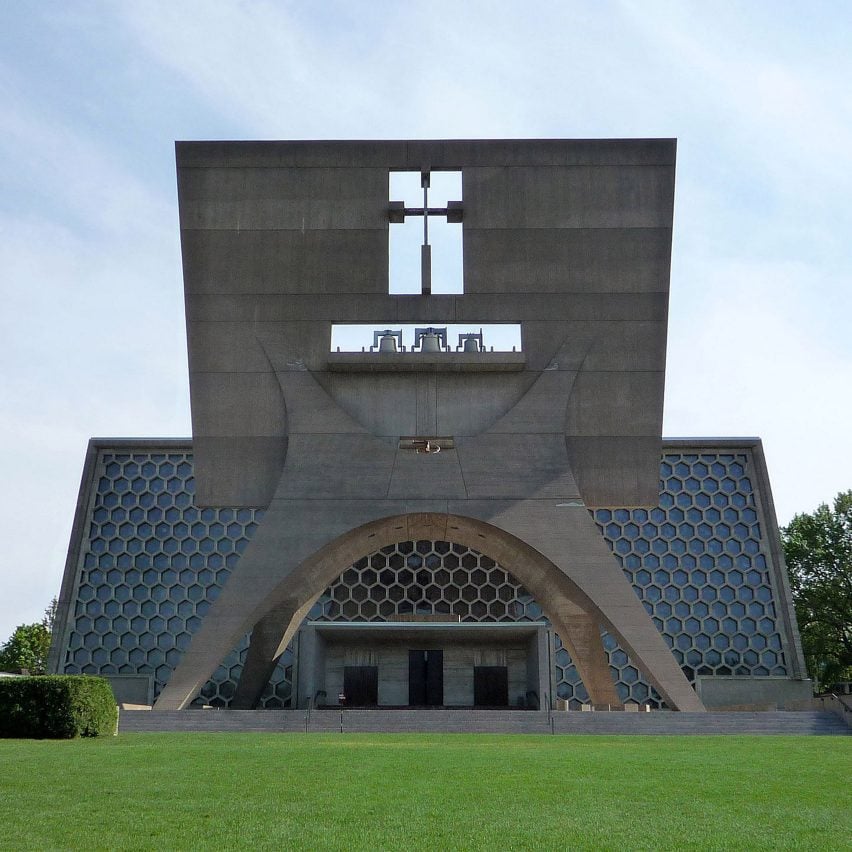US president Donald Trump‘s move to promote classical architecture over modernism is aimed at suppressing optimism for the future, writes Steven Holl.
What did Stalin do in 1933, Hitler do in 1937, and Trump do in 2025? They all tried to block the development of modernist architecture by ordering that new government buildings look like vestiges of ancient Greece or Rome.
The modernist architectural period was a fertile and very inventive period in American architecture. The optimism for the future, and the expressive architecture of a hopeful unknown, was realized in many significant projects during that time.
American works of modern architecture are positive realizations of belief in the future
Important American works of modern architecture such as IM Pei’s Mesa Laboratory in Colorado (1961), or his monumental National Gallery of Art (1978) are positive realizations of belief in the future. Their optimistic programs of science and public art were part of a great period in American cultural expression of a new sculptural architecture, sometimes referred to as brutalism.
In Pei’s first sketches of the plans for the National Gallery, we see how the site’s geometry is freely introducing an abstract play of triangles and trapezoids. This monumental modern architecture inspiringly illuminates the original diagonals of Pierre Charles L’Enfant’s masterplan.
Pei was one of the most important architects of his generation. He worked parallel to Louis Kahn, whose Richards Medical Research Laboratory at the University of Pennsylvania opened in 1965, and immediately was the focus of an exhibition of models and drawings in the Museum of Modern Art in New York. Its stark, brutalist, modern expression in the “served and servant” spaces launched Kahn’s inspiring series of inventive works of modern architecture, which continued to pour out of his office until his sudden death in 1974.
In a June 6, 1972 lecture in Aspen Colorado, Kahn pointed to “a trend towards bold and rough”, referring to the concrete of his Salk Institute (1965) as “looking a little bit angry, which of course is so charming today”. The brutal beauty of the institute frames the Pacific Ocean horizon. At certain times of the day, glistening light in the courtyard water strip merges with the sparkle of sun on the Pacific, creating a magic of infinite oceanic space.
Kahn’s buildings were a poetic homage to silence and light. Light is at the heart of Kahn’s Exeter Library (1965), where the central space of the building in beautiful structural concrete is encased in a square geometry of brick – a poetic statement of finding a book and moving from “darkness to the light”.
The fictional architect that is the focus of the recent film The Brutalist is modeled after Marcel Breuer, the Hungarian-born Bauhaus architect, who came to America in the late 1930s and had amazing opportunities in the USA building some spectacular buildings. One particularly inspiring example is the St John’s Monastery in Minnesota (1961 – pictured top), with its abstract forms and bell tower embodying the language of modernism. In Breuer’s hands, the innovative board-formed concrete architecture takes on spiritual dimensions with a honeycomb wall of stained-glass windows.
Architects should take up a focus like that of president Kennedy and resist the backwardness
Architecture, even more directly than other forms of art, leaves an experiential testament of the culture of a civilization. The space, light, material and detail of our public buildings communicate a hope (or a cynicism) to children of future generations. Our country has experienced 248 years of the freedom of democracy, until our present time of media-driven false information.
In modern political history, we have examples of attempts at dictatorial direction of architecture. Joseph Stalin’s purge of modern architecture began in 1933; the great optimistic and futuristic architectural designs of figures like Konstantin Melnikov, Moisei Ginzeburg, Ivan Leonidov, and Alexander Rodchenko all fell under his steel-toed boot. Architects were ordered by the Central Committee of the Party to turn to imitate classical architecture.
Today, the United States’ president repeats this turn against anything modern to focus on the past. The announcement that all new government buildings were to be constructed in traditional, classical architecture was also made by Adolf Hitler in 1937. These three dictatorial leaders have a key aspect in common: the suppression of any architecture focused on optimism for the future.
President John F Kennedy had a very different focus – that the government’s new architecture would be open to the new and future visions of leaders in the fields of art and architecture. It is ironic that “make America great again” refers to our brilliant and hopeful 1960s, and yet the current directive turns against the inventive moment – toward a false past also championed by Stalin and Hitler.
Today, US architects should take up a focus like that of president Kennedy and resist the backwardness, in a spirit aimed at our children in optimistic progressiveness.
Steven Holl is the principal of Steven Holl Architects. He is one of America’s best-known architects, having been awarded the Praemium Imperiale in 2014, the AIA Gold Medal in 2012 and the Cooper-Hewitt National Design Award in 2002, among other prizes. In 2001, Time Magazine declared him “America’s best architect”. He is also a professor at Columbia University and an honorary fellow of the Royal Institute of British Architects. He has written several books on architectural theory, including Urban Hopes (2013), Horizontal Skyscraper (2011) and Making Architecture (2018).
The photo is by Bobak Ha’Eri.
Dezeen In Depth
If you enjoy reading Dezeen’s interviews, opinions and features, subscribe to Dezeen In Depth. Sent on the last Friday of each month, this newsletter provides a single place to read about the design and architecture stories behind the headlines.
The post "Stalin, Hitler and Trump all tried to block modernist architecture" appeared first on Dezeen.

